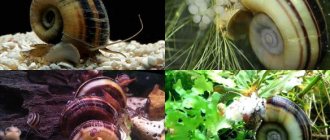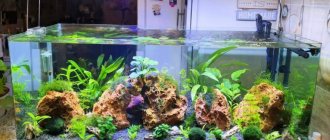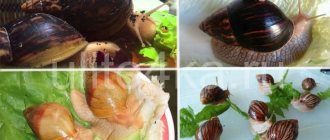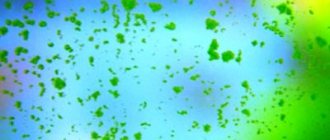Snails
Simplicity of content:
Latin name: Melanoides
Lifespan: 2 years
Maximum size: 3.5 cm.
Average cost: 20 rub.
An unusual mollusk that picks up leftover food and waste products from the surface of the soil and also cleans the soil in depth. Quickly adapts to the proposed conditions. The melania snail is unpretentious in maintenance and care, but with uncontrolled reproduction it is necessary to regulate the number of offspring.
Description and natural habitat
The homeland of the tropical gastropod family Thiaridae is located far away, in the warm and humid lands of Africa (Morocco, Madagascar, Egypt), South Asia (from the Middle East to China and Indonesia) and Australia. Thanks to its unpretentiousness and high numbers, the species is expanding into new territories and has already conquered the Caribbean, southern Europe and Brazil. Colonies settle in the ground, where they reproduce and feed on small plant foods. Melanias are viviparous, and they reproduce at a tremendous speed.
The mollusk looks similar to its fellows. The body is protected by a shell, reaching 4 cm in length in adults. The shape of the shell is narrow and long, formed in the process of evolution for comfortable living in the ground. The color of the house varies from light brown to dark with small randomly located spots. There are 2 tentacles (antennae) on the head, at the base of which are the organs of vision. It breathes oxygen dissolved in water and has gills. To protect against enemies, there is a lid at the mouth of the sink that closes in adverse weather conditions.
Communities numbering up to 35,000 individuals settle near bodies of water with weak currents. They prefer sandy and muddy areas with plenty of vegetation. They are nocturnal and sleep during the day, hiding in the ground.
Freshwater snails are so tolerant of water salinity that they can live near bodies of water with a salt level of up to 30%. The degree of oxygen saturation also does not matter. The only thing that really matters for clams is water temperature. For a comfortable stay, the liquid should be +18…+25 °C.
Photo gallery of Melanium snails:
In the aquarium, this species not only does cleaning, but is a kind of soil indicator. Spending most of the time in the ground, it instantly reacts to decay processes. In such cases, the entire colony rises up from the bottom.
Melania's average life expectancy is 2 years. This species is not hermaphrodite and two individuals will be needed to begin breeding. Males are usually larger.
Reproduction
Granifera and sand snails are viviparous mollusks. To reproduce their own kind, a female and a larger male are needed. But asexual reproduction is also not uncommon. Females can do without males. Embryos form and develop in the brood sac, which expands to accommodate up to 77 embryos. Small snails are born measuring 0.7–2 mm and immediately hide in the sand.
Young melania are so small that they cannot be seen in the ground.
The sexual maturity of melania is determined by the height of the cone. According to scientists, this figure fluctuates in the range of 5.5–12 mm. The author of 30 books about mollusks, American Robert Tucker Abbott, as a result of research, found that on average, each sexually mature female gives birth to 1 calf every 12 hours.
In order for melania to reproduce, the aquarist does not need to create suitable conditions.
Mr. Tail recommends: varieties
There are only three species of Melania in aquariums:
- Tuberculata is the most common type of mollusk. It still remains a mystery how they got into the artificial reservoir. It is suspected that this was an accident; the snail arrived from distant countries on seaweed that was imported for sale. Newborn mollusks are so small that it is impossible to see them without magnifying equipment, and they prefer to hide in the root system of plants. The long conical shell of this variety is gray in color and covered with patches and spots of green, olive and brown. Usually the shell size does not exceed 3.5 cm, but giant specimens are known that reach 8 cm in length.
- Granifer is distinguished by its slowness in everything. This species does not reproduce so quickly, moves slowly and inhabits only a small part of the reservoir. The mollusk spends more time on the surface, exploring the stones and driftwood of the bottom. The snail has a relatively wide shell, 2 cm long and 1.5-2 cm in diameter. The color of the shell is rich, with stripes and streaks of a darker shade. The pattern is parallel to the spiral.
- Riketi is a copy of Melania Tuberculata, but there are still slight differences. This snail comes from the freshwater lakes of Singapore. The size and shape of the shell are identical, only the color is closer to brown than gray. But despite the differences, not all scientists recognize them as a separate species.
Features of the view
Melania lives in Africa, and over time these mollusks began to occupy the territory of Asia. Today, snails have spread to Europe and South America. The melania snail was able to find such a diverse habitat thanks to its ability to adapt to any environment, including difficult climatic conditions.
The typical habitat for snails is the territory of reservoirs closer to the shore with slow water flow. Basically, melania is located at a distance of a meter from the surface of the water, and it is completely unusual for it to sink to the bottom of the reservoir. However, sometimes mollusks can create a colony of about 1000 individuals per square at a depth of about three meters. Snails have gills, so they absorb oxygen in the water.
The photo of the melania snail, which shows its amazing appearance, is gray in color with the presence of olive or green dots. The shell of the mollusk has the shape of a cone and ends with a curl of a different shade. Also sometimes there are individuals whose color is red or burgundy.
Aquarium Basics
Mollusks live in fresh and salted water and are absolutely independent of acidity and hardness. The main thing is to observe the temperature regime (+20…+28 °C) and install aeration. The liquid in the tank must be well saturated with oxygen.
The choice of soil is very important for keeping Melania. It is better to give preference to sand or medium-sized stones.
A lot of artificial shelters and decorative elements are installed in the reservoir: driftwood, castles, grottoes.
Plants in a pond must have a well-developed root system and hard leaves. Otherwise, the snails are able to dig up the bush or eat it.
The advantages of maintenance include the cleanliness of the tank and the quality of the soil. Snails constantly dig it up, not allowing it to sour. By eating away food debris and cleaning the glass of the aquarium, they save fish and vegetation from bacterial and fungal diseases.
The disadvantages include their numbers, which are constantly growing and cannot be controlled.
At elevated water temperatures (+30 °C), Melania's lifespan is halved.
Natural habitat
In nature, melania is found in water bodies of Asia, Australia, and the African continent. Recently, large populations of these mollusks have been observed in the southern United States and several European countries.
Melania snails prefer to settle in small bodies of water near the shore or in shallows. They rarely fall below 1 m from the surface. The favorite soil of these gastropods is soft sand with silt . Melania form numerous colonies; per 1 m² there can be up to 2000 adult individuals, and with a sufficient food supply, up to 3500.
Compatibility
Shellfish can be kept with almost all types of peaceful fish, but there are a number of natural enemies that will never leave snails alone. These pets are kept to reduce the size of the colony: cichlids, loaches, ancistrus, tetradons, macropods, gourami, and some varieties of catfish. There are also Melania's predatory relatives, such as Helena, who are also quick to eat their own kind.
It is strictly forbidden to use Kabombu in any of its varieties in an aquarium with shellfish. They will damage the delicate root system and eat the lacy leaves of the plant.
Feeding
There is no need to create any conditions for feeding; they will eat whatever is left of the other inhabitants. They also eat some soft algae, thereby helping to keep the aquarium clean.
If you want to feed additionally, you can give any tablets for catfish, chopped and lightly boiled vegetables - cucumber, zucchini, cabbage.
By the way, in this way you can get rid of an excessive amount of melania, give them vegetables, and then get the snails that have crawled onto the food.
The caught snails need to be destroyed, but do not rush to throw them into the sewer; there have been cases when they crawled back out. The simplest thing is to collect them in a bag and put them in the freezer.
Breeding and benefits
The mollusk reproduces without human intervention. It is enough to populate a few individuals into the aquarium and after a few months you will have to worry about reducing the number.
The snail is a viviparous animal, with independent offspring (from 10 to 45 pieces at a time). Easy to adapt. Regardless of how Melania got into the aquarium, it is necessary to strictly monitor the size of the colony, because the benefit of a pet quickly turns into harm.
Positive qualities include:
- Regular loosening of the soil, prevention of the formation of hydrogen sulfide.
- Cleaning the bottom and vertical surfaces of the tank from organic waste, food debris, and tiny parasitic plants.
- Filtration of microorganisms and water purification.
- Changing the chemical parameters of the liquid towards softening, through the absorption of calcium.
- Timely notification of disturbances in the oxygen balance of the tank. When the level decreases, the entire colony rises in the evening and morning hours.
Number control
These snails, as already mentioned, are useful for maintaining the balance of the biocenosis only if their numbers are limited. Due to their prolific nature, it requires considerable effort and knowledge from the aquarium owner to keep the number of snails within reasonable limits.
To completely destroy gastropods, a complete replacement of plants, calcination or scalding of the soil is required, which is quite problematic in a large aquarium. For processing, special preparations containing copper are produced. This element has a detrimental effect on shellfish, but it is also harmful to crustaceans - shrimp, crayfish. Instead of a ready-made product, you can make a solution of copper sulfate - 0.3 g for every 10 liters of aquarium water.
In addition to the chemical method, electricity is used, but both methods pose a danger to other inhabitants of the aquarium, no matter what the manufacturers promise. The least expensive and safer method is the biological method of population control. Natural enemies of snails will quickly clear the pond of excess specimens.
No less dangerous is the mechanical method, in which the aeration is turned off and the snails that float to the surface are collected. Another effective method is bait. It is used as dried, air-darkened banana peel or cabbage leaf. Mollusks collect on their surface and are easy to remove along with the bait. But this method increases the amount of organic matter and can lead to rotting of the water.
Pet stores have special traps for shellfish. Their use is less dangerous, and in combination with a biological method will help to effectively control the number of melania snails.
Harm from Melania and how to get rid of it
The main disadvantage of keeping them is the rapid growth in numbers. A large population begins to eat not only harmful, but also beneficial vegetation of the artificial reservoir.
To control the population, it is recommended to use a number of methods:
- Introducing a predatory species of Helena snails into a tank. They feed on small fellows, quickly finding and destroying them.
- Fishing with scalded zucchini. Place the vegetable in the aquarium in the evening. In the morning it will be covered with snails; it will be enough to remove it along with part of the colony.
- Collecting animals manually or using a net, the procedure will be repeated many times. This is a labor-intensive and ineffective method.
- Turning off the aeration will cause Melania to starve of oxygen, and she will rise to the surface, where she can be easily collected. This method is dangerous as it can negatively affect other pets living in the tank.
Nutrition
These snails can also feed on soft-leaved plants.
The diet of melania is based on lower algae and semi-decomposed organic remains. Being typical detritivores (creatures that feed on decaying organic material), they will not refuse scalded lettuce, cucumber or zucchini, as well as leftover fish food.
With a lack of food, the growth and development of snails slows down. Nutrient deficiency slows down the reproduction process.
Video about Melania snail:
Conclusion
The Melania snail can not only become an uninvited guest, it can also be an integral part of the aquarium interior.
Maintaining and breeding it is not difficult. The mollusk is unpretentious to the parameters of the aquatic environment, the main thing is that it is warm enough - it does not tolerate cold. It plays the role of a cleaner, but if there is an excess population, it causes a disturbance in the biobalance and sloppiness of the aquarium. It can be difficult to completely get rid of such snails, so it is necessary to initially closely monitor possible occurrences and prevent overpopulation of these creatures. Then Melania will only benefit aquarium owners.
If you decide to diversify your underwater fauna with this type of gastropod, the best option would be Melania granifera. She is more attractive in appearance, it is not difficult to observe her, because she does not constantly hide in the ground in search of food.
Share with friends on social media. networks
10% DISCOUNT FOR BUYERS FROM REGIONS OF RUSSIA AND CIS COUNTRIES FOR AQUARIUMS, FISH, PLANTS, ETC.
Neretina
This snail is one of the most beautiful mollusks for an aquarium. The main disadvantage is the high requirements for living conditions. Since the mollusk does not breed in captivity, its price is high. The shell of individuals is smooth, shaped like an egg. The color is catchy, it combines red, green and dark, almost black tint.
Neretina is useful. It perfectly fights any algae on glass and decorations, does not injure vegetation and is neutral towards other inhabitants of the container.
Snails in an aquarium. So what conclusion can be drawn whether they are needed in the aquarium or not?
My personal opinion on this matter is this. In a decorative aquarium, which is, for example, an interior decoration. The presence of the same coil snails in large numbers is unacceptable. Crowds of multiplied coils crawling on the glass obviously will not add beauty to the aquarium. But several large bright ampularia, especially with an unusual shell color, will look quite good. On the other side. For example, like in my 60 liter aquarium without a filter with cherry shrimp. Hundreds of coils are not at all annoying since the aquarium is located almost on the floor; under a large aquarium they are not noticeable. And this aquarium is not considered as decorative, but rather as experimental.
Also snails may be considered more of a pest in planted aquariums. In which delicate and whimsical plants are grown. From the category of helpers and orderlies, snails quickly move into the category of pests and, of course, they must be combated.
In any case, there is no such type of snail that, by placing it in an aquarium, you can forget all the problems; in any case, the aquarist will have to clean the glass from various algal foulings.
What to feed Melania
These mollusks do not require any special additional nutrition. They are detritivores, meaning they eat semi-decomposed organic matter. In this regard, an incorrect judgment has been created that Melania is aggressive and attacks fish, kills them and begins to eat. In fact, she simply eats fish that have already died for other reasons. Food can also be the uneaten food of other inhabitants, green plaque on the walls or snags.
You can feed the snails cabbage, zucchini, lettuce, and cucumber. Vegetables must first be boiled or poured with boiling water for 5-10 minutes. If desired, you can feed the catfish in the form of a tablet.











